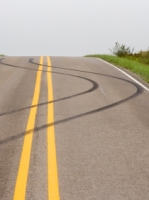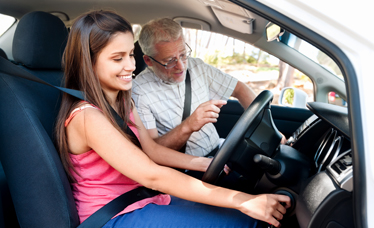Chapter 3 – Section 1
Driving Emergencies
It is vital for all drivers to be aware of the environment in which they travel, other drivers around them and the vehicle they control.
-
A. Light Rain / First Rain
-

When road conditions and surfaces change, braking distance and traction change as well.
The first rain often leads to a dangerous condition in which to operate a motor vehicle. The first rain lifts the oil up from the road surface, but it does not completely wash away the slippery substance. Many drivers do not slow down to a level that the first rain requires. Also, light rain tends to be ignored by people who continue driving as if the roads were clear and dry. What they fail to realize is that light rain makes the road slick and simply does not provide enough water to wash away all the accumulated oil and debris. During light rain or the first rain, it is best to reduce speed significantly, allow extra stopping distance, and use caution. When road conditions and surfaces change, braking distance and traction change as well.
-
B. One-Way Streets
-
Areas with heavy traffic often can be frustrating and even confusing for many drivers. One solution is to use one-way streets. Unfortunately, these types of streets pose unique dangers to drivers. Wrong way drivers are common, as are drivers making turns from the incorrect lane. You need to know how to properly enter and exit one-way streets and be prepared to slow down, change lanes or stop if necessary. Chapter 13 explains how to use one-way streets safely.

Use caution on one-way streets.
Road Emergencies
Driving on the roads of New Jersey requires attentiveness, skill, a vehicle that is responsive, a little luck, and a subconscious mind that can quickly react. When an emergency occurs on the road, the decision to act must be a split-second one, and you must know instinctively what to do. The following describes how to handle an emergency driving situation:
-
A. Skids
-
An out-of-control skid is caused when the vehicle’s tires lose contact with the road. Often, a thin layer of water gets between the tires and the road, and the vehicle begins to hydroplane. The old adage, “steer or turn into the skid,” applies only if a driver knows the intended meaning. In a skid, the back wheels of the vehicle are the ones actually skidding, with the front tires following. If you start to skid, you must turn the steering wheel in the direction the back wheels are skidding, or in other words, steer the vehicle in your intended direction. Some call it “counter” steering, while others simply call it “correcting” the skid. Regardless of what you call it, the goal is to have the wheels of the vehicle again grasp the road and find the pavement grooves.
Drivers commonly turn the steering wheel into the direction the vehicle is perceived to be skidding, which is the direction the front of the vehicle is headed. This only adds to the problem and may send the car spiraling out of control. In a car with front wheel drive, the same actions should be taken, but with some minor acceleration applied. Again, the attempt is to reconnect the car’s wheels with the pavement.

An out-of-control skid is caused when the vehicle’s tires lose contact with the road.
Special note on skids…
- Avoid turning or swerving suddenly; these actions should be done gradually.
- Don’t apply the brakes too quickly; press down gradually instead.
- Pump the brakes (except with ABS – press down ABS brakes) and don’t over-steer.
- Keep the vehicle clutch engaged, and ease your foot off the accelerator.
- Be especially careful when driving on snow or ice.
- Avoid driving on the shoulder of the road.
- When traction is poor to begin with, drive in a higher gear and accelerate gradually.
-
B. Oncoming Car / Wrong Side of the Road
-
The goal when facing a vehicle coming towards you is to take evasive action as quickly as possible. Waiting until the last second to initiate a maneuver rarely gives you enough time to avoid a collision. An early evasive move may cause, at worst, a sideswipe or a rear-end collision, but helps avoid a more dangerous head-on collision.
In order to minimize the chance of a collision, you should slow down as quickly as possible, pull to the extreme right or drive off the road completely, flash the headlights and sound the horn.
-
C. Soft Shoulders
-
The soft shoulder on highways should be used in emergency situations only. Driving on the soft shoulder is highly dangerous because it can lead to loss of vehicle control, and it is also illegal. Paved shoulders allow for optimum vehicle traction, but soft shoulders are usually just packed dirt which is unstable and should only be utilized in an emergency situation. The phrase “cold shoulder” was first used in Sir Walter Scott’s novel “The Antiquary.”
-
D. Bad Pavement
-
It is vital as a defensive driver to be aware of all road conditions that may affect your safe use of the highway. Bad pavement is a major contributing factor to many traffic collisions. For example, pot holes or bumps may cause the vehicle to lose traction with the road surface, while other factors may make it difficult to steer the vehicle. Get to know the road conditions of areas where you intend to travel prior to beginning the trip. Local law enforcement or city agencies can keep drivers updated to all road conditions. Preparation for bad pavement or taking an alternative route can help reduce the potential for a collision.
When speeds are increased during highway driving, be prepared to steer around blocked roadways or obstructions. Try and steer around any stalled cars as well, and warn other vehicles behind you by utilizing brake and hazard lights.
-
E. Drop-Offs
-
Drop-offs are dangerous shoulders of the road which drop off or are beveled into an abrupt drop from the normal roadway. Falling rain may also create a flowing gutter of water often a foot or more deep, creating an even more unstable driving situation. If for any reason your tires do drop off the side of the roadway, DO NOT APPLY THE BRAKES! The uneven traction may cause a loss of control. Take your foot off the accelerator gradually while maintaining a firm grip on the steering wheel.
-
F. Stuck in Deep Water
-

If stuck in water, wait until the pressure equalizes and open a window or door.
The best way to avoid getting stuck in deep water is to avoid flooded roads. The Denver boot keeps a vehicle stuck in place. Road workers often place roadblocks around flooded roadways to keep drivers out of trouble. If you see any of these roadblocks, it is time to look for an alternate route. Drivers who go around the barriers often find themselves requiring assistance. Be smart and use an alternate route.
An overloaded vehicle has an increased chance of stalling in water. If you run into deep water and get stuck, but do not sink, try to escape immediately through a window. If you do sink, wait until the pressure equalizes before you try and open a window or door. First get into the back seat where air pockets usually form and kick out the back window. This window is designed to come off fairly easily.
Video: “Sinking Car”
Sometimes the water rises too fast for you to get out. In other cases, you may run into deep water unexpectedly. Watch the following video to see a real-life scenario of a sinking car. Would you know what to do in the same situation?
Getting trapped in a sinking car can be a terrifying experience, but the most important thing is to stay calm. You will be able to get out alive with a little patience.















